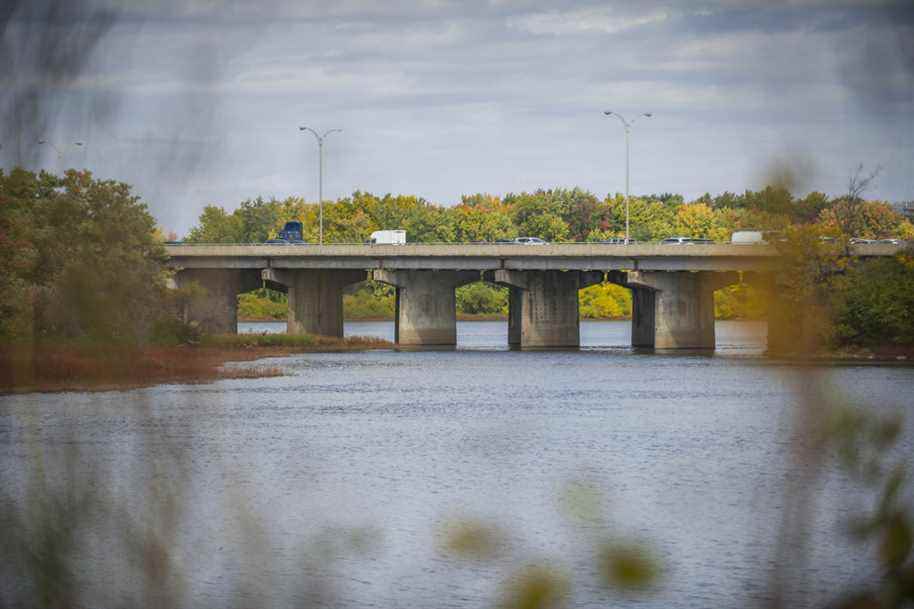The new bridge, which will be built to replace the Gédéon-Ouimet bridge by 2030, will be twice as wide as the current bridge and will be closer to residential areas and natural habitats “of high ecological value” on the islands and on the banks of the Mille Îles river, between Boisbriand and Laval.
At the beginning of September, in almost complete indifference, on the day of the first televised debate of the federal leaders, the Ministère des Transports du Québec (MTQ) announced the construction of a new bridge over a kilometer in length on the Autoroute 15. The new bridge will have four lanes of traffic in each direction, including one reserved for public transport, and a shoulder three meters wide on each side. In addition, the MTQ is “studying the relevance” of building a path for pedestrians and cyclists on one of the bridge’s two decks.
The current Gédéon-Ouimet bridge has three traffic lanes in each direction and has no shoulder. As a result, the new bridge, made up of two separate structures, will have a “deck considerably wider than the existing one”, ie “between 54 and 58 meters, depending on the option chosen”. The current bridge is 28 meters wide.
Effects on islands and coastline
From an environmental standpoint, the most significant repercussions are expected “in the coastal part of the river and [dans] the islands “. The current bridge crosses Morris Island, near a residential area, and Lefebvre Island, part of which houses the Rivière-des-Mille-Îles wildlife refuge. Widening the bridge could bring road infrastructure closer to residences and these valued natural environments, or even encroach upon them. And these are not the only ones.
According to the MTQ’s project notice, in this section of the Mille Îles River, “exceptional plant associations, large riparian wetland complexes and a concentration of endangered, vulnerable or susceptible animal and plant species have been identified. being “.
“Muskrat and fish breeding habitats are mapped near the bridge, as well as sites identified as being of ecological interest and a priority ecological development zone by Ville de Laval. The Montreal Metropolitan Community has also attributed a conservation vocation to areas under the bridge. Given the presence of wooded, wet and aquatic environments, a wide variety of species of birds, fish, amphibians and reptiles can frequent the study area. ”
The environmental impact study, which will detail all of these elements as well as the anticipated effects of the construction of the new bridge, is expected in summer 2022.
New viaduct to rebuild?
The widening of the bridge will also require a “revision of the plan geometry of Highway 15 at the location of the bridge and its approaches” and “a widening or [une] excavation of the jetty at the southern approach to the bridge ”. The highway 344 overpass, which crosses over Highway 15, on the Boisbriand side, may need to be rebuilt due to the new geometry of the A15. This structure in perfect condition was completely rebuilt in 2012.
The location of the bridge piers, which will have a major impact on the protection of the river’s natural habitats, also remains to be determined.
The announcement of the construction of the new bridge and the publication of the MTQ’s project notice launch a process of planning, design and consultation, acquisition of the necessary land and obtaining the permits, which will extend over 30 months, according to Ministry documents.
The construction of the new bridge will then extend over five years.
Built in 1958
The Gédéon-Ouimet bridge is one of the busiest bridges in the greater Montreal area. It is used every day by nearly 140,000 vehicles, on average, to cross the Mille Îles River between Laval and Boisbriand. Opened in 1958, this steel girder bridge underwent major repairs in the late 1980s. Thirty years later, it is clearly at the end of its useful life.
Corrosion is eating away at the structures, the piles age badly, blocked drains are flowing everywhere, “causing significant damage to the beams”, according to the most recent inspection report.
According to the MTQ’s project notice, the concrete slab of the bridge is “severely degraded” and undermined by de-icing salts. Expansion joints “lift” from the roadway and, when driven over, they are “felt strongly by users, affecting driving comfort”.
The steel beams in the deck are “low impact” and have “nonconforming joints”, not to mention the fact that the bridge does not meet seismic design standards for a structure of its size.
For years, the bridge has been classified as “to be replaced” in the MTQ’s inventory of structures, and long studies as well as long opinions were necessary to conclude that a complete reconstruction was indicated.
Some technical data
40: Number of piers of the current bridge
1145.7 meters: Total length of the current bridge
28 meters: Overall width (between the extreme points) of the current bridge
138,000: Number of vehicles using the bridge per day, of which 4% are trucks
26.2 hectares: Area of the Rivière-des-Mille-Îles wildlife refuge, a protected area in the south of Lefebvre Island
Source: Quebec Ministry of Transport

